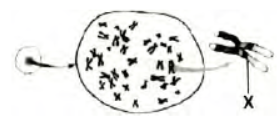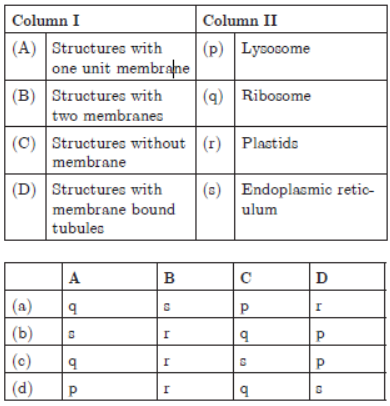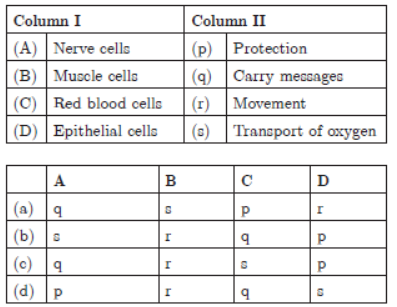Please refer to The Fundamental Unit of Life MCQ Questions Class 9 Science below. These MCQ questions for Class 9 Science with answers have been designed as per the latest NCERT, CBSE books, and syllabus issued for the current academic year. These objective questions for The Fundamental Unit of Life will help you to prepare for the exams and get more marks.
The Fundamental Unit of Life MCQ Questions Class 9 Science
Please see solved MCQ Questions for The Fundamental Unit of Life in Class 9 Science. All questions and answers have been prepared by expert faculty of standard 9 based on the latest examination guidelines.
MCQ Questions Class 9 Science The Fundamental Unit of Life
OBJECTIVE QUESTIONS
Question. Which cell organelle is not bound by a unit membrane?
(a) Lysosome
(b) Ribosome
(c) Endoplasmic reticulum
(d) Nucleus
Answer
C
Question. Which structure in plant cell is responsible for providing the energy required to drive cellular processes?
(a) Chloroplast
(b) Mitochondrion
(c) Nucleus
(d) Golgi apparatus
Answer
B
Question. Root hairs absorb water from soil by the process of
(a) plasmolysis
(b) diffusion
(c) osmosis
(d) endocytosis
Answer
C
Question. Which of the following cell organelles can make complex sugars from simple sugars?
(a) Ribosomes
(b) Lysosomes
(c) Endoplasmic reticulum
(d) Golgi apparatus
Answer
A
Question. What are suicide bags?
(a) Plastids
(b) Mitochondria
(c) Lysosomes
(d) Ribosomes
Answer
C
Question. What is the important function of nucleus?
(a) Photosynthesis
(b) Cellular reproduction
(c) Lipid synthesis
(d) Protein synthesis
Answer
B
Question. Cell theory was proposed by
(a) Robert Brown
(b) Robert Hook
(c) Schleiden and Schwann
(d) Anton von Leeuwenhoek
Answer
C
Question. Which of these is acellular?
(a) Viruses
(b) Bacteria
(c) Protozoans
(d) Fungi
Answer
A
Question. An organism has poorly defined nuclear membrane in its cells. This organism could be a/an
(a) bacteria
(b) animal
(c) fungi
(d) bird
Answer
A
Question. Largest number of cell bodies of neuron in our body are found in:
(a) retina
(b) spinal cord
(c) brain
(d) tongue
Answer
C
Question. Cell wall of plants is mainly composed of
(a) chitin
(b) cellulose
(c) lipids
(d) lignin
Answer
C
Question. The diagram below shows a magnified view of a particular part of a human cell. Name the part labelled X.

(a) Ribosome
(b) Chromosome
(c) Nucleoplasm
(d) Mitochondrion
Answer
B
Question. A plant cell placed in a hypo-tonic solution will not burst because of presence of
(a) plasma membrane
(b) cell wall
(c) chloroplast
(d) cytoplasm
Answer
B
Question. What is ‘autolysis’?
(a) Self-replication
(b) Self-digestion
(c) Self-food producers
(d) Food decomposer
Answer
B
Question. Which labelled organelles helped a student to conclude that it is a plant cell?
(a) P and R only
(b) P and S only
(c) P, R and T only
(d) P, R and U only
Answer
D
Question. A cell loses water by osmosis when kept in a solution having a lower concentration of water than the cell. The given solution is
(a) hyper-tonic
(b) hypo-tonic
(c) isotonic
(d) dilute
Answer
A
Question. Chemical nature of carrier molecules facilitating transport across plasma membrane is:
(a) starchy
(b) sugary
(c) proteinaceous
(d) fatty acidic
Answer
C
Question. X is a double membraned organelle that oxidises food present in cell to release energy. X is
(a) nucleus
(b) endoplasmic reticulum
(c) mitochondrion
(d) chloroplast
Answer
C
Question. If the ribosome of a cell are destroyed then
(a) respiration will not take place
(b) fats will not be stored
(c) carbon assimilation will not occur
(d) proteins will not be formed
Answer
D
Question. Find the best definition of ‘vacuole’?
(a) A fluid filled structure surrounded by membrane.
(b) A thread like structure containing nuclear material.
(c) A jelly like substance which is present between nucleus and cell membrance.
(d) The basic structural units of an organism.
Answer
A
FILL IN THE BLANK
Question. Genes are sub units of ………. The number and type of which vary from species to species.
Answer
Chromosomes
Question. ………. is concerned with transmission of hereditary traits from parents to offspring.
Answer
Nucleus
Question. Membrane-bound non-living structures in a cell is ……….
Answer
Vacuole
Question. The single largest cell in the world is of an ……….
Answer
Ostrich egg
Question. ………. are amoeboid cells of blood.
Answer
White blood cells
Question. ………. are clear spaces present in the cytoplasm enclosed by a membrane.
Answer
Vacuoles
Question. RNA stands for ……….
Answer
Ribo Nucleic Acid
TRUE/FALSE
Question. The oxidation of food in a cell takes place in mitochondria.
Answer
True
Question. Cell wall is a non-living layer.
Answer
True
Question. Plastids are the sites of photosynthesis.
Answer
True
Question. Compounds like pectin and proteins also occur in cell wall.
Answer
True
Question. Golgi apparatus is present in prokaryotic cell.
Answer
False
Question. Endoplasmic reticulum may be smooth or rough.
Answer
True
Question. Animal cells have larger vacuoles.
Answer
False
Question. Striking difference between a plant and animal cell is due to the presence of cell wall.
Answer
True
Question. Centrosomes are present in a plant cell.
Answer
False
Question. Cell wall is a semi-permeable membrane.
Answer
True
MATCHING QUESTIONS
Question.

Answer
(d) A – p, B – r, C – q, D – s
Question.

Answer
(c) A – q, B – r, C – s, D – p
ASSERTION AND REASON
Question. Assertion : The endoplasmic reticulum which lacks ribosomes is called smooth endoplasmic reticulum (SER).
Reason : SER is mainly involved in protein synthesis.
Options:
(a) Both assertion and reason are true and reason is the correct explanation of assertion.
(b) Both assertion and reason are true but reason is not the correct explanation of assertion.
(c) Assertion is true but reason is false.
(d) Both Assertion and Reason are false.
Answer
C
Question. Assertion : A plant cell bursts if placed in water.
Reason : High turgor pressure causes bursting of plant cells.
Options:
(a) Both assertion and reason are true and reason is the correct explanation of assertion.
(b) Both assertion and reason are true but reason is not the correct explanation of assertion.
(c) Assertion is true but reason is false.
(d) Both Assertion and Reason are false.
Answer
D
Question. Assertion : Cell wall is a non-living part of the cell.
Reason : It offers protection, definite shape and support.
Options:
(a) Both assertion and reason are true and reason is the correct explanation of assertion.
(b) Both assertion and reason are true but reason is not the correct explanation of assertion.
(c) Assertion is true but reason is false.
(d) Both Assertion and Reason are false.
Answer
A
Question. Assertion : Plasma membrane is selectively permeable.
Reason : Plasma membrane allows some molecules to pass through it more easily than others.
Options:
(a) Both assertion and reason are true and reason is the correct explanation of assertion.
(b) Both assertion and reason are true but reason is not the correct explanation of assertion.
(c) Assertion is true but reason is false.
(d) Both Assertion and Reason are false.
Answer
A
Question. Assertion : Mitochondria are called ‘powerhouses’ of the cell.
Reason : Mitochondria produce cellular energy in the form of ATP.
Options:
(a) Both assertion and reason are true and reason is the correct explanation of assertion.
(b) Both assertion and reason are true but reason is not the correct explanation of assertion.
(c) Assertion is true but reason is false.
(d) Both Assertion and Reason are false.
Answer
A
